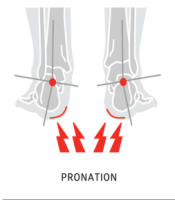The Effect of Non-prescription Orthotics on Walking Gait in Participants with Excessive Pronation
DOI:
https://doi.org/10.61838/kman.intjssh.5.2.6Keywords:
Insole Orthotics, Pronation, GaitAbstract
Background: Insole orthotics are prescribed to correct human body position during both the standing position and the motion of gait. Also, they are being applied for people who have forefoot abduction and arch deformation. However, a little is known about the relationship between forefoot and arch orthotic correction and the alternation in foot biomechanics. Objectives: This study was aimed to determine the effect of non-prescription insole orthotics in walking gait parameters. Methods: It was a quasi- experimental with pre-test, post-test design study. Twelve volunteer participants (41 ± 17 y), 10 men and two women, participated in this study. Three-dimensional (3D) cameras were used to do motion capture through those markers placed on lower body segments. Seven segments such as: Hip, left and right thigh, left and right shank, left and right foot were used for labelling in this study, which was measured with Vicon T-Series cameras at 250 Hz. The participants did walk in three different phases: Barefoot, running shoe, running shoe with a non-prescription orthotic inside. t-test was used to analyse the data. Results: The paired t-test results indicated that there is significant difference in cadence, step length and stride length for running shoe, and non-prescription orthotics compare to those of barefoot (P ≤ 0.05). Additionally, it was found that, non-prescription orthotics resulted in higher step length and stride length, and less cadence (P ≤ 0.05). On the other hand, But, no significant changes were found for non-prescription orthotics (P ≥ 0.05). Conclusions: It was concluded that cadence, step length and stride length were improved in running shoe compared to non-prescription orthotics group. But there were not any significant differences between running shoe and non-prescription orthotics.Downloads
Download data is not yet available.

Downloads
Additional Files
Published
2022-11-01
Issue
Section
Articles
How to Cite
Kakavand, M., & Smith, N. (2022). The Effect of Non-prescription Orthotics on Walking Gait in Participants with Excessive Pronation. International Journal of Sport Studies for Health, 5(2), 42-49. https://doi.org/10.61838/kman.intjssh.5.2.6




